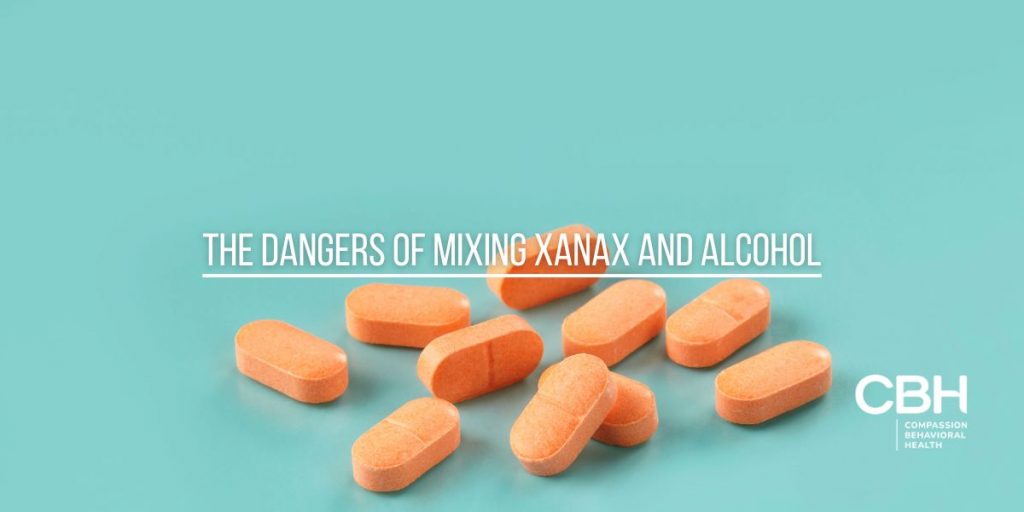Mixing Xanax and alcohol can have serious consequences for your health and well-being. When mixed, these two substances can interact negatively, heightening the risk of harmful effects. Mixing Xanax and alcohol can deepen sedation, impair cognitive and motor abilities, and substantially elevate the risk of respiratory depression and potentially fatal overdose.
Understanding the dangers of this combination is crucial for anyone who may be taking Xanax or consuming alcohol. In this article, we will explore the effects of Xanax and alcohol on their own, the risks of combining them, the scientific explanation behind the dangerous interaction, and prevention and treatment options.
How Xanax Works and Its Effects
Xanax is a prescription medication primarily prescribed for the treatment of anxiety and panic disorders. It belongs to a class of drugs called benzodiazepines, which work by enhancing the effects of a neurotransmitter called gamma-aminobutyric acid (GABA) in the brain. This increased GABA activity helps to reduce anxiety and promote relaxation.
The Role of Xanax in the Nervous System
When taken as prescribed, Xanax can be an effective treatment for anxiety. However, it is important to use Xanax only as directed by a healthcare professional and not to mix it with alcohol or other substances. Xanax acts by depressant effects on the central nervous system, producing sedation and relaxation. It works by binding to specific receptors in the brain, which enhances the inhibitory effects of GABA. While this can provide relief for individuals struggling with anxiety, combining Xanax with alcohol can intensify the sedative effects and increase the risk of dangerous outcomes.

Potential Side Effects of Xanax
Like any medication, Xanax can cause side effects, especially when not used as prescribed or when combined with alcohol.
Common side effects of Xanax include;
- Drowsiness
- Dizziness
- Confusion
- Impaired coordination
- Slowed breathing
These side effects can be amplified when alcohol is introduced, leading to excessive sedation, loss of motor control, and impaired judgment.
It is crucial to be aware of the potential side effects of Xanax and to follow the prescribed dosage carefully. Abruptly stopping Xanax can also lead to withdrawal symptoms, such as rebound anxiety, insomnia, tremors, and seizures. Therefore, it is essential to taper off the medication gradually under the guidance of a healthcare provider to minimize the risk of withdrawal effects.
Long-Term Use and Considerations
Long-term use of Xanax can lead to tolerance, where higher doses are needed to achieve the same effects. This can increase the risk of dependence and addiction. It is important for individuals prescribed Xanax to regularly reassess the need for the medication with their healthcare provider and explore alternative treatments or therapies to manage anxiety.
The Impact of Alcohol on the Body
Alcohol is a central nervous system depressant that affects various systems and organs in the body. The effects of alcohol vary depending on factors such as the amount consumed, frequency of use, and individual tolerance. It is essential to understand how alcohol affects the body to recognize the potential dangers of combining it with Xanax.
When alcohol is consumed, it is rapidly absorbed into the bloodstream through the stomach and small intestine. From there, it travels to the brain, where it exerts its primary effects on the central nervous system. The liver plays a crucial role in metabolizing alcohol, breaking it down into byproducts that can be eliminated from the body. However, excessive alcohol consumption can overwhelm the liver’s capacity, leading to a buildup of toxic substances and potential liver damage over time.
How Alcohol Affects the Brain
Alcohol acts as a sedative, reducing the activity of the central nervous system. It enhances the effects of GABA, similar to Xanax, resulting in relaxation and decreased inhibitions. However, alcohol also affects other neurotransmitters, such as glutamate, which can lead to impaired cognitive function, decreased coordination, and memory problems.
Furthermore, chronic alcohol abuse can cause changes in the brain’s structure and function. Prolonged exposure to alcohol can lead to a tolerance to its effects, requiring individuals to consume increasing amounts to achieve the same level of intoxication. This cycle of tolerance and dependence can ultimately result in addiction, making it challenging to stop drinking despite negative consequences.
Long-Term Consequences of Alcohol Consumption
Excessive and prolonged alcohol use can have severe long-term consequences. Chronic alcohol abuse can lead to organ damage, including liver disease, cardiovascular problems, and neurological impairments. It is crucial to be aware of the potential risks associated with alcohol use and to seek help if alcohol abuse becomes a concern.
In addition to physical health issues, alcohol misuse can also have significant social and emotional impacts. Relationships may suffer, work performance may decline, and individuals may experience feelings of guilt, shame, or isolation. Seeking support from healthcare professionals, counselors, or support groups can be instrumental in addressing the complex challenges of alcohol addiction and promoting recovery.
The Risks of Xanax and Alcohol Interactions
Combining Xanax and alcohol can amplify the effects of each substance, leading to a heightened risk of adverse outcomes. The dangers associated with this combination cannot be overstated, as it can result in severe health complications and even be life-threatening in some cases.
It is crucial to note that the interaction between Xanax and alcohol is not just a simple additive effect. When these two substances are combined, they can have a synergistic effect on the central nervous system, intensifying their individual impacts. This can result in a dangerous cascade of effects on the body, affecting everything from cognitive function to respiratory health.

Immediate Health Risks
Mixing Xanax and alcohol can lead to immediate health risks, such as extreme drowsiness, confusion, and impaired judgment. It can also cause severe respiratory depression, which can be dangerous, especially when mixed with the sedative effects of alcohol. The combination can also increase the risk of accidents, falls, and other injuries.
Furthermore, the combination of Xanax and alcohol can lead to a higher likelihood of blackouts, where individuals have no recollection of events that occurred while under the influence. This can not only be distressing but also potentially dangerous, as it may involve engaging in risky behaviors without any memory of them.
Long-Term Health Implications
Regularly combining Xanax and alcohol can have long-term health implications. Prolonged use can lead to liver damage, memory problems, and an increased risk of developing an addiction to either or both substances. It is important to understand the potential risks involved and seek professional help if you or someone you know is struggling with Xanax and alcohol abuse.
Moreover, the chronic combination of Xanax and alcohol can have profound effects on mental health, exacerbating symptoms of anxiety and depression. This can create a vicious cycle where individuals may turn to these substances in an attempt to self-medicate, only to worsen their mental health conditions in the long run. Seeking comprehensive treatment that addresses both substance use and mental health concerns is essential for breaking free from this harmful cycle.
The Science Behind the Dangerous Interaction
The dangerous interaction between Xanax and alcohol can be explained by how both substances are metabolized in the body and their impact on the central nervous system.
The Role of the Liver in Drug and Alcohol Metabolism
The liver plays a crucial role in metabolizing both Xanax and alcohol. However, when alcohol and Xanax are ingested together, the liver may prioritize the metabolism of alcohol over Xanax. This can result in increased levels of Xanax in the body, prolonging its effects and potentially leading to overdose or other complications.
Furthermore, chronic alcohol consumption can affect the liver’s ability to metabolize Xanax efficiently. This can further exacerbate the risk of Xanax toxicity when combined with alcohol, as the body struggles to process and eliminate both substances effectively.

How Xanax and Alcohol Interact in the Body
Xanax and alcohol both depress the central nervous system. When combined, they can enhance each other’s sedative effects, leading to increased sedation, impaired coordination, and memory problems. The combination can also slow down heart rate and breathing, which can be life-threatening in severe cases.
Moreover, the simultaneous use of Xanax and alcohol can increase the risk of respiratory depression, where breathing becomes dangerously slow and shallow. This is particularly risky for individuals with underlying respiratory conditions or those who already have compromised lung function. The synergistic effects of Xanax and alcohol on respiratory function can further heighten the potential for respiratory failure, a critical medical emergency that requires immediate intervention.
Prevention and Treatment Options
Recognizing the signs of Xanax and alcohol abuse and seeking help is crucial for preventing the dangers associated with their combination. There are various prevention and treatment options available for individuals struggling with substance abuse.
When it comes to preventing Xanax and alcohol abuse, education and awareness play a key role. Understanding the risks and consequences of combining these substances can empower individuals to make informed decisions about their health and well-being. Additionally, creating a strong support system and engaging in healthy activities can help reduce the likelihood of turning to substances for coping.
Recognizing Signs of Xanax and Alcohol Abuse
Signs of Xanax and alcohol abuse may include changes in behavior, increased secrecy, neglecting responsibilities, and physical symptoms such as drowsiness and impaired coordination. If you or someone you know is exhibiting these signs, it is important to seek professional help for an accurate diagnosis and appropriate treatment.
Furthermore, it’s essential to address any underlying mental health issues that may be contributing to substance abuse. Dual diagnosis treatment, which focuses on both substance abuse and co-occurring mental health disorders, can provide comprehensive care and improve long-term outcomes for individuals seeking recovery.
Steps Towards Recovery and Treatment
Recovery and treatment for Xanax and alcohol abuse often involve a combination of medical interventions, therapy, and support. Detoxification may be necessary to safely rid the body of the substances, followed by counseling and behavioral therapies to address underlying issues and develop healthy coping mechanisms. Support groups and aftercare programs can also provide ongoing support and guidance throughout the recovery process.
Moreover, exploring alternative therapies such as mindfulness practices, art therapy, or yoga can complement traditional treatment approaches and promote overall well-being during the recovery journey. It’s important for individuals in recovery to find activities that bring them joy and fulfillment, helping them build a meaningful life beyond substance abuse.
Combining Xanax and alcohol can have severe consequences for your health and well-being. It is crucial to understand the dangers, recognize the signs of abuse, and seek professional help if needed. Remember, your health and safety should always be a top priority.
Treatment for Xanax and Alcohol Abuse at CBH in South Florida

If you or a loved one is struggling with the dangerous combination of Xanax and alcohol, Compassion Behavioral Health is here to offer a ray of hope. Our specialized team is committed to fostering sustainable recovery through personalized treatment plans. Located in the serene setting of South Florida, our Hollywood rehab center provides a tranquil environment conducive to healing. Don’t let substance abuse control your life any longer. Call Us Today and start your journey to reclaiming your health and happiness.



